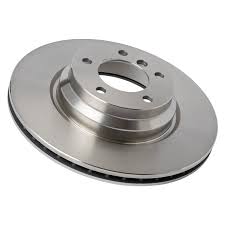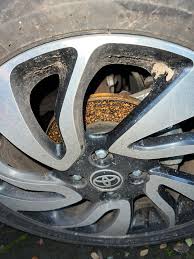Views: 0 Author: LUEN Groups Publish Time: 2024-11-09 Origin: Site












A brake disc, also known as a brake rotor, is a crucial component in modern disc brake systems found on most vehicles today. It functions as the stationary part that, when engaged by the brake pads, slows down or stops the rotation of the wheels. Made from heat-resistant materials such as cast iron or carbon-ceramic composites, brake discs are designed to withstand significant thermal stress and mechanical wear while providing efficient braking performance.

Brake disc rust is a common phenomenon, especially in humid or rainy climates, and after periods of inactivity, like during winter storage. Rust forms when iron (a primary component of brake discs) reacts with oxygen and water, creating iron oxide—the reddish-brown substance we recognize as rust. While rust on other vehicle parts might be a sign of neglect, brake discs are particularly susceptible due to their exposure to the elements and the nature of their operation.
Regular Use of Driving: Frequent use of your vehicle helps keep brake discs warm, which discourages rust formation. Short drives even on dry days can help.
Coatings: Applying anti-rust coatings or ceramic brake pads can provide an extra layer of protection against rust.
Garage Storage: Keeping your car in a garage, especially during rainy or snowy seasons, can shield it from direct moisture exposure.
Waxing:Waxing the wheel hubs and surrounding areas can create a barrier that repels water, indirectly protecting the brake discs.
Rust on brake discs isn't necessarily a cause for immediate concern. Light surface rust typically wears off during the first few brake applications after a period of inactivity. However, severe rust—characterized by thick, flaky deposits—can affect braking performance by reducing friction between the pads and discs, leading to longer stopping distances and potential brake noise. It's essential to monitor rust buildup and address it promptly to maintain optimal brake performance and safety.

Cleaning rusty brake discs involves a few steps, but it's crucial to do so safely to avoid damaging other brake components:
Safety First: Ensure the vehicle is securely parked and the engine is off. Allow the brakes to cool completely before starting.
Remove Wheels: Jack up the car and remove the wheels to access the brake discs directly.
Use a Brake Cleaner: Apply a non-abrasive brake cleaner to the discs, following the manufacturer's instructions. Avoid getting cleaner on brake pads, calipers, or other sensitive parts.
Scrub Gently: Use a soft brush or cloth to gently scrub the surface rust. Avoid using metal tools that could scratch the disc surface.
Rinse and Dry: Rinse off the cleaner thoroughly with clean water and dry the area with a clean cloth or compressed air.
Reassemble: Put the wheels back on and torque them to specification. Test drive the vehicle carefully to ensure proper braking function.
Remember, if rust is severe or if you're unsure about performing the cleaning yourself, consulting a professional mechanic is advisable. They can assess the condition of your brake system and recommend necessary repairs or replacements to ensure your safety on the road.
while rusty brake discs might be an inevitable part of vehicle ownership, understanding their cause, implementing preventive measures, and knowing how to clean them effectively can help maintain your braking system's integrity and performance. Regular inspections and prompt attention to rust can keep your car stopping safely and efficiently, extending the life of your brake components.
Rust on brake discs can be a common occurrence, especially if the vehicle has been sitting for a while or has been exposed to moisture. A small amount of surface rust is usually harmless and will wear away as the brakes are used. However, if the rust is severe or causes surface pitting and pitting on the disc surface, it could affect braking performance and safety. It's a good idea to have your brake discs inspected by a professional if you're concerned about the rust or if you notice any unusual noises or braking issues. Always prioritize safety when it comes to your vehicle's braking system!
A little rust on brake pads is usually okay, especially if they’ve been sitting for a while, as it can be a normal part of the wear process. However, if you notice significant rust or pitting, it could compromise their effectiveness. Generally, it's best to have them checked if the rust appears excessive or if you hear unusual noises when braking. Safety first!
It's not uncommon to see some rust on brake components, especially if the vehicle has been sitting for a while or if it's exposed to moisture. Brake rotors, in particular, can develop surface rust quickly when they aren't used regularly. However, excessive rust could indicate a problem that may affect braking performance. If the rust is severe or you're experiencing issues like squeaking or reduced braking power, it might be wise to have them inspected by a professional. Remember, safety first!